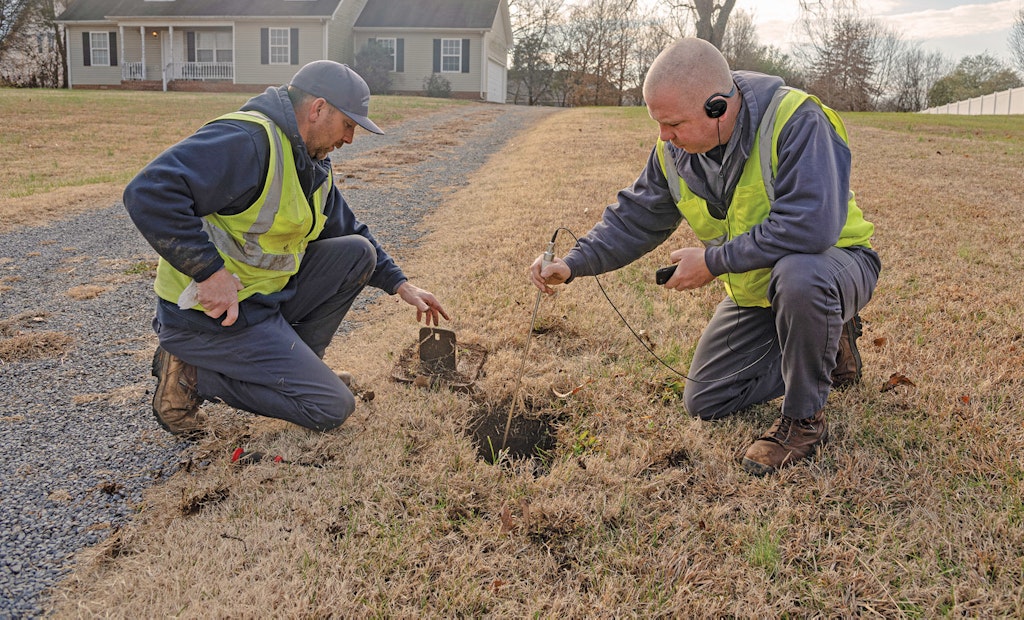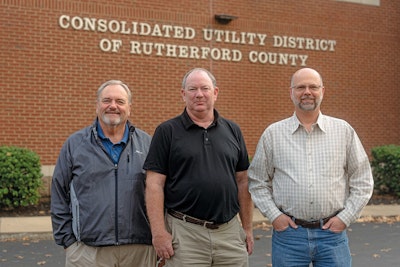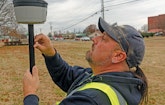
Chris Jacobs (left) and lead technician Bryan Harvey of the Consolidated Utility District in Rutherford County, Tennessee, listen for a leak in a water service line. (Photography by Martin Cherry)
When you think of trendsetters, you may have visions of New York, Los Angeles or Chicago.
But in the field of water management, few providers are out in front of the Consolidated Utility District of Rutherford County, Tennessee.
Based in Murfreesboro, the utility is successfully dealing with a rapid population growth through a range of water service improvements totaling more than $38 million. According to Brett McArdle, communications officer, these improvements include advanced metering technology, upgraded GIS and mapping, leak detection, water quality control, and expansion of the utility’s water conveyance and treatment facilities.
“With our proximity to Nashville, Rutherford County is literally growing overnight,” McArdle says. “We’re adding 3,000 customers a year and will be at 150,000 in a few years. We’re already the sixth largest water utility in the state, and we’re poised to grow larger.”
Ultimately, customers will benefit. The advancements are designed to produce high-quality water, keep customers informed of water use, and control costs.
The utility
The Consolidated Utility District has grown substantially since its start in 1968, but its motto remains the same: “Take Care of Every Drop.”
Today, the utility serves some 60,000 accounts in Rutherford County outside Murfreesboro. Drawing raw water from Percy Priest Lake on the East Fork of the Stones River, the utility treats it to drinking water standards at its K. Thomas Hutchinson Water Treatment Plant, which is being expanded from 16 to 30 mgd (see sidebar).
Treated water flows to customers through more than 1,400 miles of water mains, with 20 pumping stations serving 20 different pressure zones. The utility maintains 12 reservoirs with a total storage capacity of 22.4 mg.
New AMI system
A new metering system is one of the most significant upgrades and will enable the utility to spot leaks on a 24/7 basis and help customers save water and money.
“Right now, we use a drive-by radio read system, which communicates with one-way automated meter reading modules,” says Mike Sumner, director of information technology. “We have signed a $1.3 million contract with Itron, an energy and water resource management company, to improve our metering capabilities from AMR to AMI.”
Sumner says the district will start by converting some 13,000 meters — about one-fourth of its customers — to the Itron system by March of this year, with more connections being upgraded over the next three years.
The new meters will be connected to the utility’s autodialer and enable the district to notify customers immediately of leaks in their water system.
Eventually, Sumner says, the data will be displayed via a web-based portal system enabling customers to see their usage in real time.
“For a time, we’ll be a blended system,” says Bryant Bradley, director of operations. “Some of our service area is very rural, and it’s not feasible to install AMI there.” He estimates that ultimately 60% of the utility’s district will be AMI, 40% AMR.
The utility will benefit, too. Bradley explains that many of the district’s customers are rental units, which have frequent shut-offs and reconnections as tenants move out and move in.
“The new system is going to save us a lot of trucks and time going to the site,” he says. “It will be a huge advantage for us.”
Leak detection
Using Sewerin detectors and correlators, the district has maintained an exemplary leak detection program for years and sends crews to other utilities in the state to teach about leak detection. It benchmarks its water loss statistics against comparable utilities and focuses on the overnight minimum hourly flow rates entering district metered areas.
These flows are compared with daytime flow rates and, in rural areas, calculated gallons per minute lost per mile of main to establish and adjust priorities for leak detection and pipe replacement.
With AMI, leak detection will be even faster and more precise, Bradley says. “In years past, the technology would alert us to a leak sometime within a 30-day period. Soon, AMI will alert us within 24 hours. Then we can notify customers that day with a call and a follow-up email.”
“Itron gives us lots more technology,” Sumner says. “We will have the capability of acoustical leak detection with the meter readings. We’ll be able to listen and record data.”
Currently, the utility must pull leak data off its SCADA system and put the data into spreadsheets. “We don’t do this every day,” Sumner says. “It’s very labor intensive. We do it every two or three weeks.”
GIS and mapping
If Rutherford County residents see drones flying overhead, they may be from their water utility.
“We employ two FAA-certified drone pilots and two drones,” McArdle says. “We plan to add thermal cameras to provide even better leak detection.”
He says the drones help increase the accuracy of the district’s GIS maps (Esri), yielding high-value snapshots for inventory control and piping.
“We’d taken 30,000 snapshots by the end of 2019,” McArdle says. “They provide good images, ensuring accurate maps for our field employees without requiring people to climb around on structures. They’re our eye in the sky.”
He adds that the utility is working with a developer to build a mobile app that will feature a personal dashboard with payment and rate information for customers. A wide area network upgrade will allow district employees to access GIS data more quickly.
Water quality and inspections
To increase water quality control, the district has installed zone jumpers and chlorinators at all pump stations. The result is a significant reduction in the amount of flushing needed to maintain quality in pressure zones, says Alan Stuemke, director of engineering. As an example, he points to March 2017, when the district flushed 1.3 million gallons. “In March 2019, we flushed 327,000 gallons.”
In addition, the district has embarked on a long-term effort to develop a complete district metering area program for the whole county. According to Stuemke, the utility is also deploying new software called Baseform to integrate with the district’s SCADA system, providing even more information about water loss and leaks.
Education is part of the water-quality effort, as well. The district’s water-quality inspectors provide training at functions in Rutherford County, including public schools, and deliver presentations to the Tennessee Association of Utility Districts. Subject matter ranges from guidance for customer service to the science of pressure differentials and water quality.
Main rehabbing
Not all of the improvements in service at the district are so high-tech. The utility continues to upgrade and rehab its 1,400-mile-long water main system.
“We tend to use conventional trench excavation for the vast majority of our pipe replacement projects,” McArdle says. “Ductile iron is our go-to material.”
He says the district uses trenchless technology for road crossings or long lines where the water meter is on the opposite side of the road from the water main.
In addition to providing concrete benefits to its customers and saving time and money for the utility, the district’s improvements and innovations are attracting the attention of others in the industry who stand to gain from its experience.
“We have a lot of other water quality and inspections personnel visiting our utility to see what we’re doing. Plus, we’re providing training to inspectors from around the state,” McArdle says.
“We’re very proud of that.”
Expanding treatment
Customers of the Consolidated Utility District of Rutherford County in Tennessee need more water.
To fulfill that need, the district is nearly doubling the capacity of its K. Thomas Hutchinson Water Treatment Plant, enabling the facility to produce 30 mgd of potable water.
“We’ve been right at capacity (16 mgd) during the summer months,” says Chris Forte, water plant manager. The expanded plant won’t add any new technologies but will add on to the treatment train already in place.
Forte says larger high service pumps (Peerless Pump) have already been added, as has a fourth raw water intake, drawing water from Percy Priest Lake on the East Fork of the Stones River.
The old flocculation-sedimentation basins are being rehabilitated, and two more are being added, bringing the total to six.
Twelve new WesTech Engineering filters are being added to the existing 12 dual-media sand and anthracite final filters. The on-site bleach and chlorine dioxide generation facilities are also being expanded to provide disinfection and maintain chlorine residual.
A new solids handling facility was added a few years ago. Process sludge and backwashed filter solids are dewatered on Andritz Separation centrifuges and disposed of on utility-owned land across the street from the treatment plant.
The expansions, totaling over $15 million, are designed to enable the district to provide drinking water for nearly 500,000 people by the year 2035.









